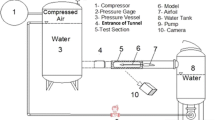Abstract
In the present paper, a new simulation method is developed for unsteady cavitating flow with air ventilation, which is very useful for alleviating the pressure oscillation in hydroturbine draft tube and reducing the drag force on an underwater vehicle. Because the fluid includes three components, i.e., the water, vapor, and air, the interactions between water–air and water–vapor are treated by applying the level set method, and the effect of surface tension is taken into account in governing equations. Further, the phase change between the water and the vapor is modeled by a homogeneous model, where the effect of air injection is considered by applying the air volume fraction in the mass transport equation. For calibration, the cavitating flows around a cylinder vehicle were simulated using the proposed method, and the numerical results were compared with the experimental data at three different ventilation conditions. The good agreement of cavitation evolutions between the simulation and the experiment indicated that the proposed method was acceptable for the simulation of ventilated cavitating flows with nature cavitation and would be usable for various engineering applications. Moreover, the vorticity analysis depicts that the vortex is closely related to cavitation evolution, and air injection much changes the vorticity production in cavitating flow. It was also revealed that vorticities only occurred in regions with high vapor/air volume fraction and the vortex stretching term created the most vorticities.
摘要
通气空化非常有利于减轻水轮机尾水管中的压力脉动、减小水下航行体的运动阻力。针对这些实际存在的空化现象,本文发展了一种适合于非定常通气空化流动模拟的新方法。对于通气空化而言,由于流动介质包含了3种成分(即水、蒸汽与空气),水与空气之间及水与蒸汽之间的相互作用采用Level-set方法处理,而在流动控制方程中考虑了表面张力效应。为了考虑水与蒸汽的相变,采用了均质空化模型,并在空气的质量输运方程中考虑了通气的影响。本文利用该方法模拟了绕圆柱形航行体在3种通气条件下的空化流动,并将数值计算结果与实验数据进行了对比。结果表明采用新模拟方法的计算可以很好地再现实验中的自然空化与通气空化并存时的空化演变,从而验证了该模型未来应用于不同领域类似工程问题的可能性。为了进一步阐释通气空化流动特性,通过涡分析方法揭示了通气空化条件下空化与漩涡之间存在紧密的相互影响关系,而通入空气会大幅改变空化流动中的漩涡运动。此外,漩涡主要发生在流场中蒸汽或空气含量较高的区域,且涡输运方程中的涡拉伸项对漩涡产生的贡献率最显著。







Similar content being viewed by others
References
Jacob T (1993) Evaluation sur Modele Reduit et Prediction de la Stabilite de Fonctionnement des Turbines Francis. Dissertation. École Polytechnique Federale de Lausanne
Kercan V, Bajd M, Djelić V et al (1996) Model and prototype draft tube pressure pulsations. Hydraul Mach Cavitation 2:994–1003
Zuo ZG, Liu SH, Liu DM et al (2014) Numerical predictions and stability analysis of cavitating draft tube vortices at high head in a model Francis turbine. Sci China Technol Sci 57:2106–2114
Bosioc AI, Susan-Resiga R, Muntean S (2012) Unsteady pressure analysis of a swirling flow with vortex rope and axial water injection in a discharge cone. J Fluids Eng 134:081104
Susan-Resiga R, Vu TC, Muntean S (2006) Jet control of the draft tube vortex rope in Francis turbines at partial discharge. In: Proceedings of the 23rd IAHR Symposium on hydraulic machinery and systems, pp 17–21
Nakanishi K, Uedo T (1964) Air supply into draft tube of Francis turbine. Fuji Electr Rev 10:81–91
Qian ZD, Yang J, Huai W (2007) Numerical simulation and analysis of pressure pulsation in Francis hydraulic turbine with air admission. J Hydrodyn 19:467–472
Liao WL, Ji JT, Lu P et al (2008) Effect of air admission through center hole of turbine shaft on the flow in draft tube. J Hydraul Eng 8:1005–1011 (in Chinese)
Chen X, Lu CJ (2005) Numerical simulation of ventilated cavitating flow around a 2d foil. J Hydrodyn 17:607–614
Zhou JJ, Yu KP (2011) Numerical simulation on the process of supercavity development and the planning state of supercavitating vehicle. J Ship Mech 3:199–206
Chang YC, Hou TY, Merriman B et al (1996) A level set formulation of Eulerian interface capturing methods for incompressible fluid flows. J Comput Phys 124:449–464
Huang B, Wang G, Zhang M et al (2011) Level set method for simulation of cavitating flows. J Ship Mechanic 3:207–216
Li HY, Yap YF, Lou J et al (2015) Numerical modelling of three-fluid flow using the level-set method. Chem Eng Sci 126:224–236
Ji B, Luo XW, Zhang Y et al (2010) A three-component model suitable for natural and ventilated cavitation. Chin Phys Lett 27:171–174
Yu A, Ji B, Huang RF et al (2015) Cavitation shedding dynamics around a hydrofoil simulated using a filter-based density corrected model. Sci China Technol Sci 58:864–869
Duan L (2014) Study on characteristics of ventilated cavitating flows around an axisymmetric body. Dissertation, Beijing Institute of Technology
Wu J, Wang GY, Fu XN et al (2005) Time-dependent turbulent cavitating flow computations with interfacial transport and filter-based models. Int J Numer Methods Fluids 49:739–761
Huang B, Wang G (2011) A modified density based cavitation model for time dependent turbulent cavitating flow computations. Chin Sci Bull 56:1985–1992
Wu Q, Wang GY, Fu XN et al (2014) Numerical study on multiphase flows around a plane. Trans Beijing Inst Technol 34:475–479
Ji B, Luo XW, Wu Y et al (2013) Numerical analysis of unsteady cavitating turbulent flow and shedding horse-shoe vortex structure around a twisted hydrofoil. Int J Multiph Flow 51:33–43
Ji B, Luo XW, Peng XX et al (2013) Three-dimensional large eddy simulation and vorticity analysis of unsteady cavitating flow around a twisted hydrofoil. J Hydrodyn 25:510–519
Acknowledgments
This work was supported by the National Natural Science Foundation of China (51179091, 51306018, 51206087 and 51376100) and the State Key Laboratory for Hydroscience and Engineering (2014-KY-05 and 2015-E-03). The authors would like to express the sincere thanks to Beijing Institute of Technology for providing the experimental data.
Author information
Authors and Affiliations
Corresponding author
Ethics declarations
Conflict of interest
The authors declare that they have no conflict of interest.
About this article
Cite this article
Yu, A., Luo, X. & Ji, B. Analysis of ventilated cavitation around a cylinder vehicle with nature cavitation using a new simulation method. Sci. Bull. 60, 1833–1839 (2015). https://doi.org/10.1007/s11434-015-0916-7
Received:
Accepted:
Published:
Issue Date:
DOI: https://doi.org/10.1007/s11434-015-0916-7




